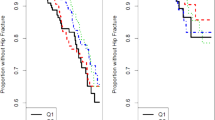Abstract
The autonomic nervous system (ANS) has attracted attention as a regulator of bone remodeling and the effects of beta-blockers on the prevention of osteoporosis have been studied. However, results are as yet inconclusive and the physiological role of the ANS in bone metabolism has not been clarified. Thus, we investigated the relationship between bone mineral density (BMD) and ANS activity in non-medicated perimenopausal women. ANS activity was evaluated by power spectral analysis of heart rate variability, and overall ANS activity and the balance between sympathetic and parasympathetic nervous activities (SNS and PNS) were quantified. Pre- and postmenopausal subjects were divided into higher or lower overall ANS activity groups, and were also divided into SNS- and PNS-dominant groups. BMD (percentage of young adult mean) was significantly higher in the higher overall ANS group than in the lower group (112.2 ± 16.2 % vs 99.7 ± 14.8 %, p < 0.05) of premenopausal subjects, but not in postmenopausal subjects (91.5 ± 15.9 % vs 91.0 ± 14.9 %). BMD was significantly higher in the SNS-dominant group than in the PNS-dominant group (94.1 ± 16.3 % vs 88.4 ± 18.8 %, p < 0.05) of postmenopausal subjects, but not in the premenopausal subjects (103.5 ± 18.4 % vs. 107.2 ± 14.6 %). Our study revealed that ANS influences bone metabolism under physiological conditions. Thus, it appears to be worthwhile to introduce ANS activity evaluation into the management of bone health in perimenopausal women.

Similar content being viewed by others
References
Ducy P, Amling M, Takeda S, Priemel M, Schilling AF, Beil FT, Shen J, Vinson C, Rueger JM, Karsenty G (2000) Leptin inhibits bone formation through a hypothalamic relay: a central control of bone mass. Cell 100:197–207
Takeda S, Elefteriou F, Levasseur R, Liu X, Zhao L, Parker KL, Amstrong D, Ducy P, Karsenty G (2002) Leptin regulates bone formation via the sympathetic nervous system. Cell 111:305–317
He JY, Jiang LS, Dai LY (2011) The roles of the sympathetic nervous system in osteoporotic diseases: a review of experimental and clinical studies. Ageing Res Rev 10:253–263
Rejnmark L, Vestergaard P, Kassem M, Christoffersen BR, Kolthoff N, Brixen K, Mosekilde L (2004) Fracture risk in perimenopausal women treated with beta-blockers. Calcif Tissue Int 75:365–372
Levasseur R, Dargent-Molina P, Sabatier JP, Marcelli C, Breart G (2005) Beta-blocker use, bone mineral density, and fracture risk in older women: results from the Epidemiologie de l’Osteoporose prospective study. J Am Geriatr Soc 53:550–552
Reid IR, Gamble GD, Grey AB, Black DM, Ensrud KE, Browner WS, Bauer DC (2005) beta-blocker use, BMD, and fractures in the study of osteoporotic fractures. J Bone Miner Res 20:613–618
Sosa M, Saavedra P, Gomez de Tejada MJ, Mosquera J, Perez-Cano R, Olmos JM, Munoz-Torres M, Amerigo ML, Moro MJ, Diaz-Curiel M, Alegre J, Malouf J, Del Pino J, Nogues X, Torrijos A, GIUMO Cooperative Group (2011) Beta-blocker use is associated with fragility fractures in postmenopausal women with coronary heart disease. Aging Clin Exp Res 23:112–117
Task Force of the European Society of Cardiology and the North American Society of Pacing and Electrophysiology (1996) Heart rate variability: standards of measurement, physiological interpretation and clinical use. Circulation 93:1043–1065
Kimura T, Matsumoto T, Akiyoshi M, Owa Y, Miyasaka N, Aso T, Moritani T (2006) Body fat and blood lipids in postmenopausal women are related to resting autonomic nervous system activity. Eur J Appl Physiol 97:542–547
Matsumoto T, Miyawaki T, Ue H, Kanda T, Zenji C, Moritani T (1999) Autonomic responsiveness to acute cold exposure in obese and non-obese young women. Int J Obes Relat Metab Disord 23:793–800
Amano M, Kanda T, Ue H, Moritani T (2001) Exercise training and autonomic nervous system activity in obese individuals. Med Sci Sports Exerc 33:1287–1291
Kim KZ, Shin A, Lee J, Myung SK, Kim J (2012) The beneficial effect of leisure-time physical activity on bone mineral density in pre- and postmenopausal women. Calcif Tissue Int 91:178–185
Conflict of interest
All authors have no conflict of interest.
Author information
Authors and Affiliations
Corresponding author
About this article
Cite this article
Miyasaka, N., Akiyoshi, M. & Kubota, T. Relationship between autonomic nervous system activity and bone mineral density in non-medicated perimenopausal women. J Bone Miner Metab 32, 588–592 (2014). https://doi.org/10.1007/s00774-013-0534-x
Received:
Accepted:
Published:
Issue Date:
DOI: https://doi.org/10.1007/s00774-013-0534-x




